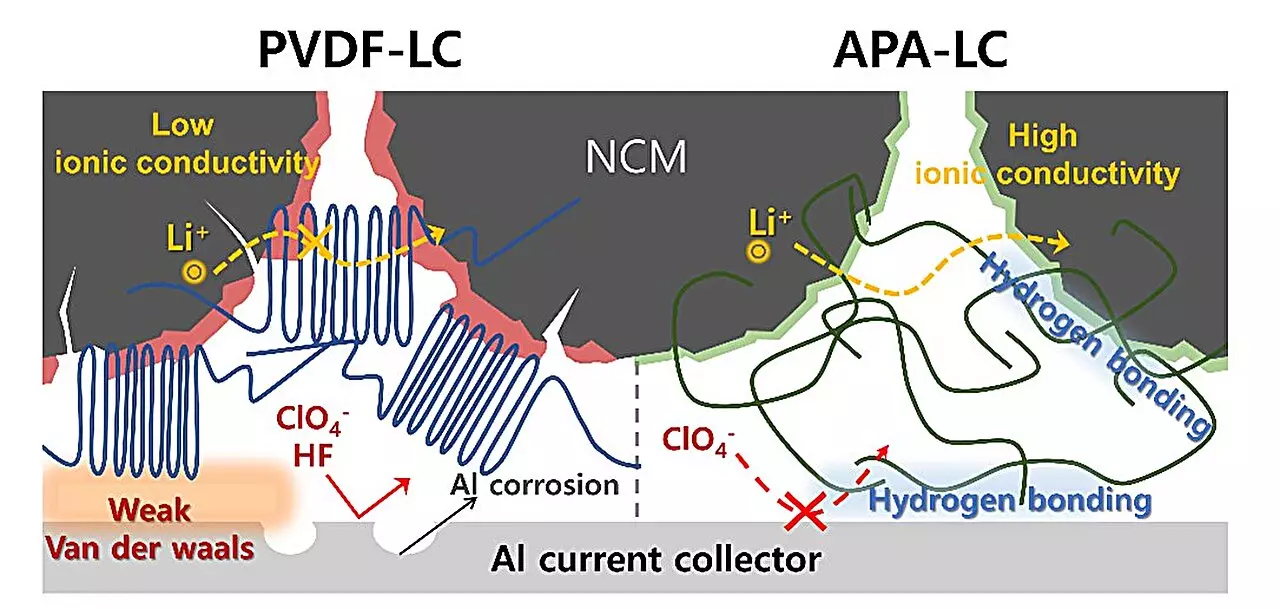The urgent need for sustainable energy solutions has never been more critical. As the world grapples with environmental degradation and climate change, the quest for greener technologies is becoming a priority. Recently, a groundbreaking innovation emerged in the realm of battery technology, showcasing a pioneering alternative to traditional lithium batteries that often rely on harmful fluorinated compounds. This new development, heralded by a research team from POSTECH and Hansol Chemical, could revolutionize the industry, driving us closer to sustainable electrification.
Lithium-ion batteries have become the cornerstone of various applications, from portable electronics to electric vehicles (EVs). However, these batteries pose significant environmental challenges. Traditional systems, such as those incorporating polyvinylidene fluoride (PVDF) binders and lithium hexafluorophosphate (LiPF6) salts, are not only inefficient in performance but also contribute to severe ecological risks. The breakdown of these fluorinated compounds produces hydrogen fluoride, a highly toxic substance that can have detrimental effects on human health and the environment.
In light of increasing regulatory pressures, particularly from entities like the European Union, which plans to implement stricter regulations on per- and polyfluoroalkyl substances (PFAS) by 2026, the urgency for innovation is more pronounced. With the non-biodegradable nature of common binders like PVDF, the industry has faced compounding concerns about waste and sustainability. Hence, the emergence of eco-friendly alternatives is not just a game changer; it is a necessity.
In response to these challenges, the research undertaken by POSTECH and Hansol Chemical introduces a viable alternative known as the “APA-LC” system. Central to this innovation is the decision to develop a non-fluorinated aromatic polyamide (APA) binder and a lithium perchlorate (LiClO4) electrolyte. Unlike their traditional counterparts, these components are free from harmful fluorinated substances, providing a significant advantage in terms of environmental impact.
The advantages of the APA-LC system extend beyond its eco-friendliness. The APA binder significantly enhances electrode stability by improving the bond between the cathode’s active materials and the aluminum current collector. This development is crucial as it mitigates corrosion in the electrolyte, allowing for an extended lifespan of the battery. Additionally, the lithium perchlorate-based electrolyte is designed to lower the energy barrier at the interface, facilitating faster lithium ion migration, which contributes to better performance metrics.
The transition to the APA-LC system has exhibited promising results in performance tests. The new system has shown greater oxidation stability and a remarkable 20% increased capacity retention after 200 cycles when subjected to rapid charge/discharge conditions at a rate of 1 C, demonstrating its potential to greatly outperform traditional systems. This achievement, validated in laboratory coin cell tests, puts the APA-LC system at the forefront of battery technology, paving the way for its application in high-capacity pouch cells.
The implications for the battery industry are profound. With the increasing demand for sustainable energy solutions, the introduction of a fully non-fluorinated battery could reshape market dynamics. As highlighted by Professor Soojin Park from POSTECH, this innovation not only serves the dual purpose of replacing fluorinated systems but also showcases enhanced performance and durability. His insights underscore the potential for these materials to lead the charge in a more sustainable battery industry.
As significant players like Hansol Chemical aim to solidify their market presence in the eco-friendly battery materials sector, it is essential to continue the research and development of these new materials. As Managing Director Young-Ho Yoon emphasized, addressing regulatory concerns pertaining to PFAS not only complies with legal requirements but also opens doors to lucrative opportunities in the global battery market, projected to reach KRW 1.7 trillion by 2026.
The collaborative efforts of POSTECH and Hansol Chemical underline the potential benefits of fostering partnerships in pursuit of sustainable innovations. As the industry begins to adopt these practices, the positive transformation towards greener energy storage solutions will be paramount, ultimately influencing both business dynamics and environmental outcomes.
The exploration of non-fluorinated battery materials marks a critical milestone in the development of sustainable energy technologies. The APA-LC system stands as a beacon of hope for a greener future, marrying performance with ecological responsibility, and setting a compelling precedent for future innovations in battery technology.

